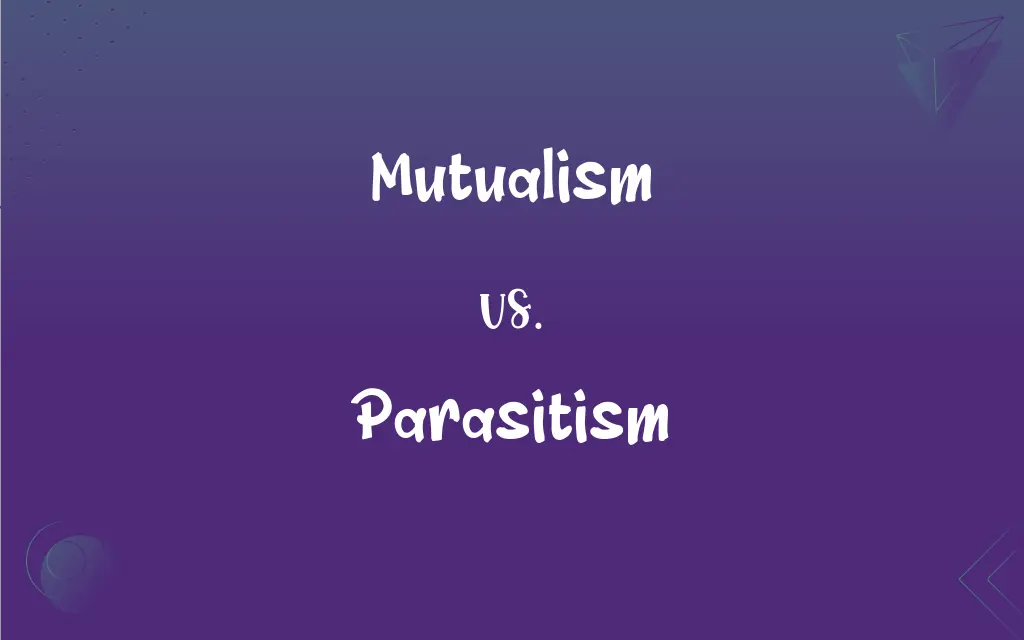Mutualism vs. Parasitism: What's the Difference?
Edited by Harlon Moss || By Aimie Carlson || Published on November 23, 2023
Mutualism is a symbiotic relationship where both parties benefit, whereas parasitism involves one organism benefiting at the expense of the other.

Key Differences
Mutualism is a type of symbiotic relationship where both organisms involved gain benefits, enhancing each other's survival or well-being. In contrast, parasitism is a relationship where one organism, the parasite, benefits at the expense of the other, the host.
In mutualism, the interactions are often essential for the life cycle or health of the involved species, like pollination by bees for flowers. Parasitism, however, often results in harm to the host, as seen in tapeworms living in the intestines of mammals.
Mutualistic relationships can involve resource or service exchange, such as ants protecting aphids in exchange for honeydew. Parasitic relationships are characterized by the parasite deriving nutrients at the host's expense, like fleas feeding on a dog's blood.
Mutualism can evolve into interdependent relationships, where both species cannot survive without the other, like in the case of certain gut flora in humans. Parasitism, though, typically involves the parasite having a minimal impact on its host's survival, like lice on humans.
Examples of mutualism include the relationship between clownfish and sea anemones, where both parties gain protection. In parasitism, examples include ticks on animals, where the tick benefits while the host may suffer from blood loss and disease transmission.
ADVERTISEMENT
Comparison Chart
Relationship Nature
Beneficial to both parties
Beneficial to one party, harmful to the other
Typical Interactions
Resource or service exchange
One-sided exploitation for resources
Impact on Participants
Generally positive or essential for both
Positive for parasite, negative for host
Dependency Level
Often interdependent or cooperative
Parasite depends on host, host usually harmed
Common Examples
Pollination, gut flora
Tapeworms, fleas, lice
ADVERTISEMENT
Mutualism and Parasitism Definitions
Mutualism
Mutualism is a symbiotic relationship where both species benefit.
The mutualism between bees and flowers involves pollination in exchange for nectar.
Parasitism
Parasitism refers to a relationship where the parasite depends on the host.
Lice demonstrate parasitism by living on and feeding off human hosts.
Mutualism
Mutualism is a cooperative interaction between different species.
The mutualism between rhinos and oxpeckers includes the birds eating ticks off the rhinos.
Parasitism
Parasitism is a relationship where one organism benefits at the expense of another.
In parasitism, a tapeworm absorbs nutrients from its host's digestive system.
Mutualism
Mutualism is a relationship of mutual support between species.
The mutualism of fig trees and fig wasps involves wasps pollinating the trees and laying eggs inside the fruit.
Parasitism
Parasitism involves an organism living on or in a host, harming it.
Fleas are an example of parasitism, feeding on the blood of mammals.
Mutualism
Mutualism refers to a symbiosis where both parties gain advantages.
In mutualism, legumes and nitrogen-fixing bacteria benefit each other; plants gain nitrogen, bacteria get carbohydrates.
Parasitism
Parasitism is a one-sided symbiotic relationship benefiting the parasite.
Mistletoe plants exhibit parasitism by extracting water and nutrients from their host trees.
Mutualism
Mutualism involves two organisms providing reciprocal benefits.
In coral reefs, the mutualism between algae and coral provides food for algae and essential habitat for coral.
Parasitism
Parasitism is a biological interaction where the parasite harms the host.
Mosquitoes exhibit parasitism by sucking blood and potentially transmitting diseases.
Mutualism
An association between two organisms of different species in which each member benefits.
Parasitism
A relationship between two organisms of different species in which one is a parasite and the other is a host.
Mutualism
(ecology) Any interaction between two species that benefits both; typically involves the exchange of substances or services.
Parasitism
The characteristic behavior or mode of existence of a parasite or parasitic population.
Mutualism
An economic theory and anarchist school of thought that advocates a society where each person might possess a means of production, either individually or collectively, with trade representing equivalent amounts of labor in the free market.
Parasitism
Parasitosis.
Mutualism
The doctrine of mutual dependence as the condition of individual and social welfare.
Parasitism
(ecology) Interaction between two organisms, in which one organism (the parasite) benefits and the other (the host) is harmed.
Mutualism
The relation between two different species of organisms that are interdependent; each gains benefits from the other
Parasitism
(figuratively) A similar interaction between people.
We accused her of parasitism in taking his hard-earned money for new dresses.
Parasitism
The state or behavior of a parasite; the act of a parasite.
Parasitism
The state of being parasitic.
Parasitism
The relation between two different kinds of organisms in which one receives benefits from the other by causing damage to it (usually not fatal damage)
FAQs
What is parasitism?
It's a relationship where one organism benefits at the expense of another.
Can mutualism be obligatory?
Yes, some mutualistic relationships are essential for both species' survival.
What's an example of parasitism in forests?
Mistletoe plants parasitizing trees are common in forest ecosystems.
Is parasitism always harmful?
Parasitism is generally harmful to the host, though the degree can vary.
How do parasites adapt to their hosts?
Parasites often evolve specialized traits to exploit their hosts effectively.
Are humans affected by parasitism?
Yes, humans can host various parasites like tapeworms and lice.
What is mutualism?
It's a symbiotic relationship where both species benefit.
Are parasites always smaller than their hosts?
Typically, but there are exceptions where parasites can be relatively large.
Do mutualism relationships evolve?
Yes, mutualistic relationships can evolve over time for better cooperation.
Do parasites always kill their hosts?
Not always; many parasites coexist without killing their hosts.
How do parasites impact human health?
They can cause various diseases and health complications.
What's an example of mutualism in marine environments?
Clownfish and sea anemones are a classic example of marine mutualism.
What are the risks of parasitism to ecosystems?
Parasitism can imbalance ecosystems and harm species populations.
Can mutualism switch to parasitism?
In rare cases, mutualistic relationships can become parasitic.
Is mutualism common in plants?
Yes, many plants have mutualistic relationships with pollinators and fungi.
How does mutualism benefit ecosystems?
It promotes biodiversity and stability in ecosystems.
Can mutualism occur between animals and plants?
Yes, such as pollinators and flowering plants.
Are all symbiotic relationships either mutualism or parasitism?
No, there's also commensalism where one benefits and the other is unaffected.
Is mutualism vital for agriculture?
Yes, especially for crop pollination and soil health.
Can mutualism lead to new species formation?
In some cases, mutualistic relationships can drive speciation.
About Author
Written by
Aimie CarlsonAimie Carlson, holding a master's degree in English literature, is a fervent English language enthusiast. She lends her writing talents to Difference Wiki, a prominent website that specializes in comparisons, offering readers insightful analyses that both captivate and inform.
Edited by
Harlon MossHarlon is a seasoned quality moderator and accomplished content writer for Difference Wiki. An alumnus of the prestigious University of California, he earned his degree in Computer Science. Leveraging his academic background, Harlon brings a meticulous and informed perspective to his work, ensuring content accuracy and excellence.






































































